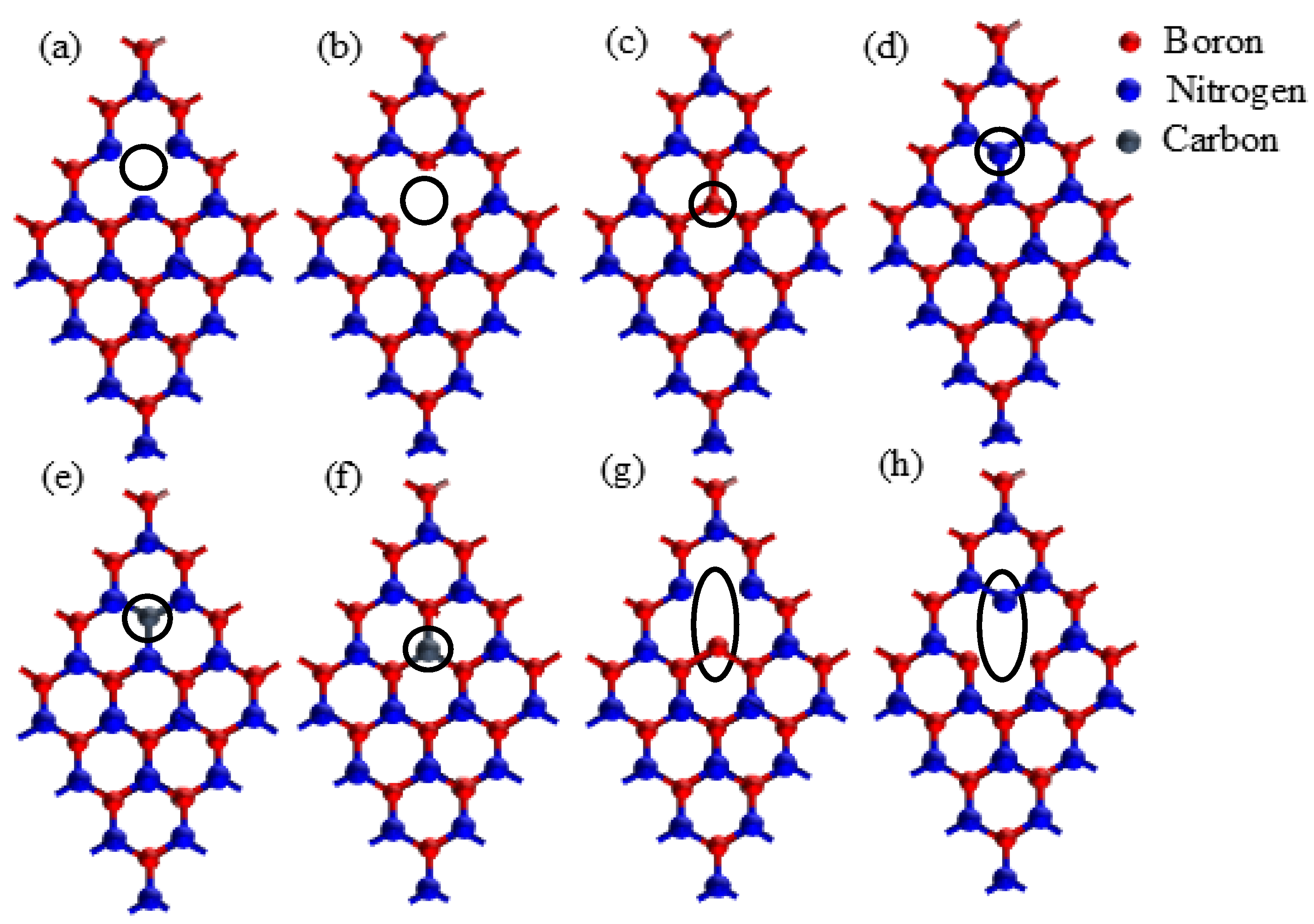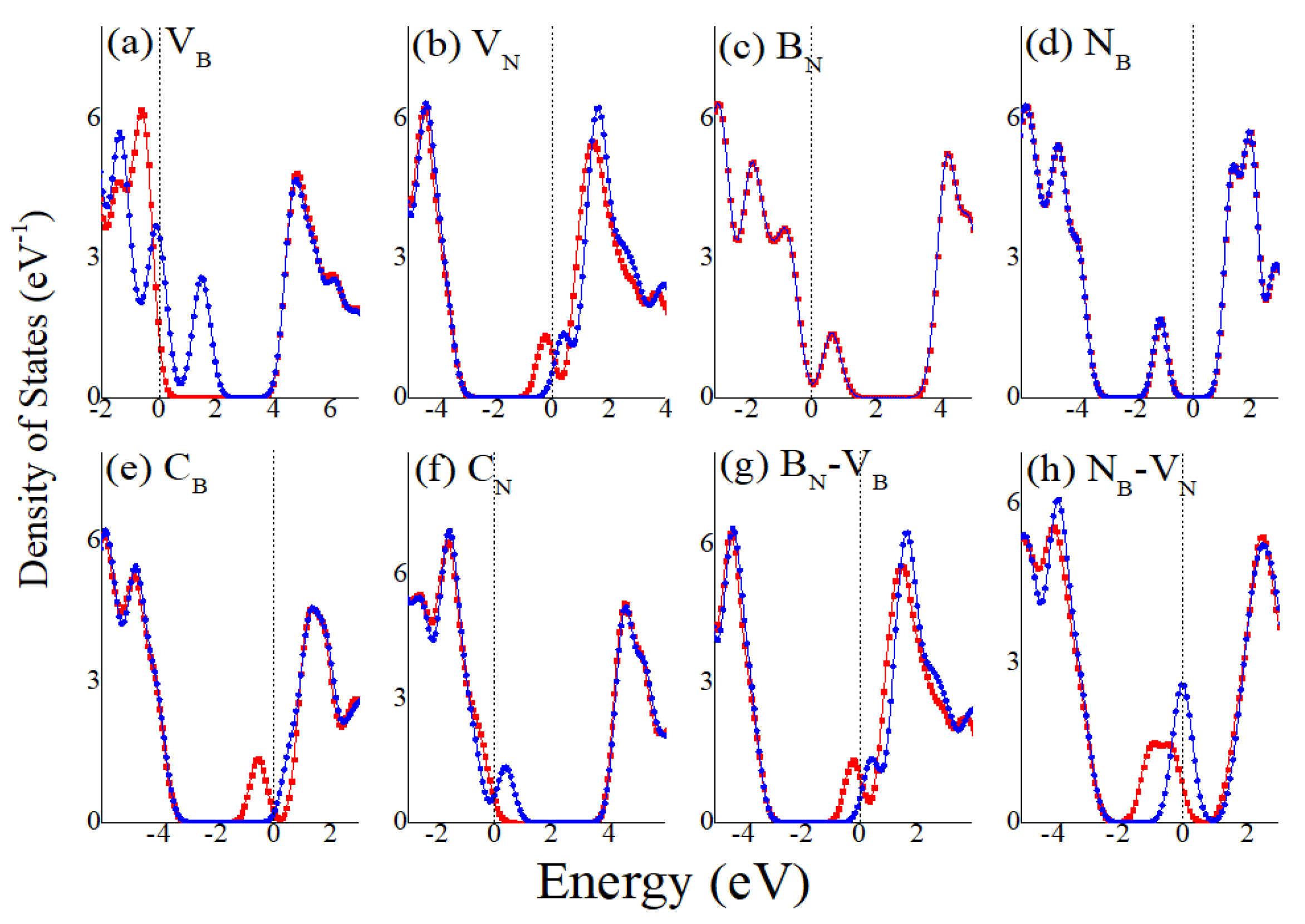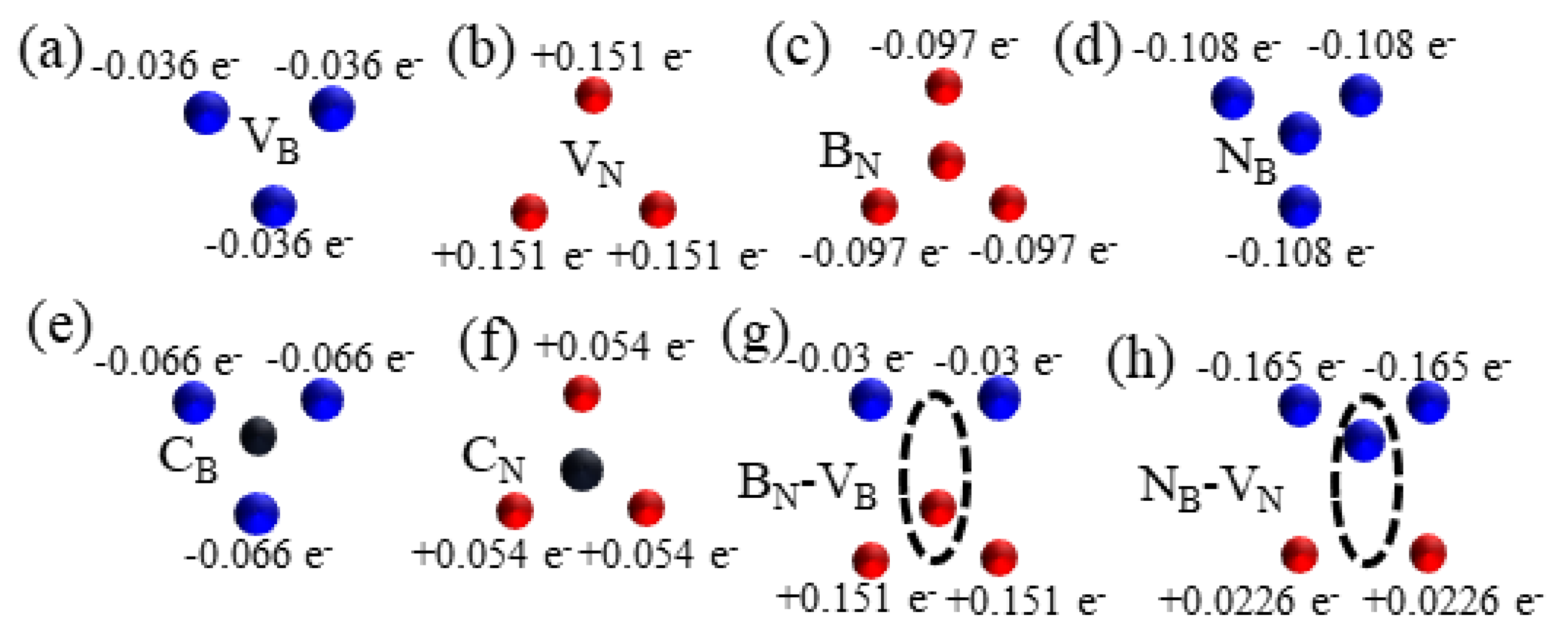Spin-Resolved Visible Optical Spectra and Electronic Characteristics of Defect-Mediated Hexagonal Boron Nitride Monolayer
Abstract
:1. Introduction
2. Materials and Methods
3. Results
4. Conclusions
Supplementary Materials
Author Contributions
Funding
Conflicts of Interest
References
- Tsay, Y.F.; Vaidyanathan, A.; Mitra, S.S. Electronic structure and optical properties of cubic BN. Phys. Rev. B 1979, 19, 5422. [Google Scholar] [CrossRef]
- Larach, S.; Shrader, R.E. Electroluminescence from Boron Nitride. Phys. Rev. 1956, 102, 582. [Google Scholar] [CrossRef]
- Johnson, Q.; Mitchell, A.C. First X-ray Diffraction Evidence for a Phase Transition during Shock-Wave Compression. Phys. Rev. Lett. 1972, 29, 1369. [Google Scholar] [CrossRef]
- Gielisse, P.J.; Mitra, S.S.; Plendl, J.N.; Griffis, R.D.; Mansur, L.C.; Marshall, R.; Pascoe, E.A. Lattice Infrared Spectra of Boron Nitride and Boron Monophosphide. Phys. Rev. 1967, 155, 1039. [Google Scholar] [CrossRef]
- Kleinman, L.; Phillips, J.C. Crystal Potential and Energy Bands of Semiconductors. II. Self-Consistent Calculations for Cubic Boron Nitride. Phys. Rev. 1960, 117, 460. [Google Scholar] [CrossRef]
- Yu, S.; Tabibi, B.; Li, Q.; Seo, F.J. Piezoelectric enhancement of a defect-mediated boron nitride nanotube. J. Phys. D Appl. Phys. 2019, 52, 335304. [Google Scholar] [CrossRef]
- Watanabe, K.; Taniguchi, T.; Kanda, H. Direct-bandgap properties and evidence for ultraviolet lasing of hexagonal boron nitride single crystal. Nat. Mater. 2004, 3, 404–409. [Google Scholar] [CrossRef]
- Guo, H.; Gao, J.; Ishida, N.; Xu, M.; Fujita, D. Characterization of two-dimensional hexagonal boron nitride using scanning electron and scanning helium ion microscopy. Appl. Phys. Lett. 2014, 104, 031607. [Google Scholar] [CrossRef]
- Arnaud, B.; Lebègue, S.; Rabiller, P.; Alouani, M. Huge Excitonic Effects in Layered Hexagonal Boron Nitride. Phys. Rev. Lett. 2006, 96, 026402. [Google Scholar] [CrossRef] [Green Version]
- Jin, C.; Lin, F.; Suenaga, K.; Iijima, S. Fabrication of a Freestanding Boron Nitride Single Layer and Its Defect Assignments. Phys. Rev. Lett. 2009, 102, 195505. [Google Scholar] [CrossRef] [Green Version]
- Kubota, Y.; Watanabe, K.; Tsuda, O.; Taniguchi, T. Deep Ultraviolet Light-Emitting Hexagonal Boron Nitride Synthesized at Atmospheric Pressure. Science 2007, 317, 932–934. [Google Scholar] [CrossRef] [PubMed] [Green Version]
- Jiang, J.; Liang, Q.; Meng, R.; Yang, Q.; Tan, C.; Sunab, X.; Chen, X. Exploration of new ferromagnetic, semiconducting, and biocompatible Nb3X8 (X = Cl, Br or I) monolayers with considerable visible and infrared light absorption. Nanoscale 2017, 9, 2992–3001. [Google Scholar] [CrossRef] [PubMed]
- Yang, Q.; Zhang, S.; Tan, C.; Ye, H.; Ming, X.; Ingebrandt, S.; Chen, X. Considering the spin–orbit coupling effect on the photocatalytic performance of AlN/MX2 nanocomposites. J. Mater. Chem. C 2017, 5, 9412–9420. [Google Scholar] [CrossRef]
- Yu, S.; Xiong, H.D.; Eshun, K.; Yuan, H.; Li, Q. Phase transition, effective mass, and carrier mobility of MoS2 monolayer under tensile strain. Appl. Surf. Sci. 2015, 325, 27–32. [Google Scholar] [CrossRef]
- Yu, S.; Zhu, H.; Eshun, K.; Shi, C.; Zeng, M.; Li, Q. Strain-engineering the anisotropic electrical conductance in ReS2 monolayer. Appl. Phys. Lett. 2016, 108, 191901. [Google Scholar] [CrossRef]
- Eshun, K.; Xiong, H.D.; Yu, S.; Li, Q. Doping induces large variation in the electrical properties of MoS2 monolayers. Solid-State Electron. 2015, 106, 44–49. [Google Scholar] [CrossRef]
- Zhang, Z.; Guo, W. Energy-gap modulation of BN ribbons by transverse electric fields: First-principles calculations. Phys. Rev. B 2008, 77, 075403. [Google Scholar] [CrossRef] [Green Version]
- Zhang, Z.; Guo, W. Tunable Ferromagnetic Spin Ordering in Boron Nitride Nanotubes with Topological Fluorine Adsorption. J. Am. Chem. Soc. 2009, 131, 6874–6879. [Google Scholar] [CrossRef]
- Zhang, Z.; Guo, W.; Yakobson, B.I. Self-modulated band gap in boron nitride nanoribbons and hydrogenated sheets. Nanoscale 2013, 5, 6381–6387. [Google Scholar] [CrossRef] [Green Version]
- Wang, V.; Ma, N.; Mizuseki, H.; Kawazoe, Y. First-principles study of intrinsic defect properties in hexagonal BN bilayer and monolayer. Solid State Commun. 2012, 152, 816–820. [Google Scholar] [CrossRef]
- Hou, S.; Birowosuto, M.D.; Umar, S.; Anicet, M.A.; Tay, R.Y.; Coquet, P.; Tay, B.K.; Wang, H.; Teo, E.H.T. Localized emission from laser-irradiated defects in 2D hexagonal boron nitride. 2D Mater. 2018, 5, 015010. [Google Scholar] [CrossRef]
- Auwärter, W.; Muntwiler, M.; Osterwalder, J.; Greber, T. Defect lines and two-domain structure of hexagonal boron nitride films on Ni(1 1 1). Surf. Sci. 2003, 545, L735–L740. [Google Scholar] [CrossRef]
- Wong, D.; Velasco, J., Jr.; Ju, L.; Lee, J.; Kahn, S.; Tsai, H.; Germany, C.; Taniguchi, T.; Watanabe, K.; Zettl, A.; et al. Characterization and manipulation of individual defects in insulating hexagonal boron nitride using scanning tunnelling microscopy. Nat. Nanotechnol. 2015, 10, 949–953. [Google Scholar] [CrossRef]
- Tran, T.T.; Bray, K.; Ford, M.J.; Toth, M.; Aharonovich, I. Quantum emission from hexagonal boron nitride monolayers. Nat. Nanotechnol. 2016, 11, 37–41. [Google Scholar] [CrossRef] [PubMed]
- Exarhos, A.L.; Hopper, D.A.; Grote, R.R.; Alkauskas, A.; Bassett, L.C. Optical Signatures of Quantum Emitters in Suspended Hexagonal Boron Nitride. ACS Nano 2017, 11, 3328–3336. [Google Scholar] [CrossRef] [PubMed] [Green Version]
- Grosso, G.; Moon, H.; Lienhard, B.; Ali, S.; Efetov, D.K.; Furchi, M.M.; Jarillo-Herrero, P.; Ford, M.J.; Aharonovich, I.; Englund, D. Tunable and high-purity room temperature single-photon emission from atomic defects in hexagonal boron nitride. Nat. Commun. 2017, 8, 705. [Google Scholar] [CrossRef]
- Kianinia, M.; Fröch, S.W.J.E.; Bradac, C.; Aharonovich, I. Generation of Spin Defects in Hexagonal Boron Nitride. ACS Photonics 2020, 7, 2147–2152. [Google Scholar] [CrossRef]
- Xu, Z.Q.; Elbadawi, C.; Tran, T.T.; Kianinia, M.; Li, X.; Liu, D.; Hoffman, T.B.; Nguyen, M.; Kim, S.; Edgar, J.H.; et al. Single photon emission from plasma treated 2D hexagonal boron nitride. Nanoscale 2018, 10, 7957–7965. [Google Scholar] [CrossRef] [Green Version]
- Mendelson, N.; Chugh, D.; Reimers, J.R.; Cheng, T.S.; Gottscholl, A.; Long, H.; Mellor, C.J.; Zettl, A.; Dyakonov, V.; Beton, P.H.; et al. Identifying carbon as the source of visible single-photon emission from hexagonal boron nitride. Nat. Mater. 2021, 20, 321–328. [Google Scholar] [CrossRef]
- Sajid, A.; Thygesen, K.S. VNCB defect as source of single photon emission from hexagonal boron nitride. 2D Mater. 2020, 7, 031007. [Google Scholar] [CrossRef]
- Turiansky, M.E.; Alkauskas, A.; Bassett, L.C.; Walle, C.G.V. Dangling Bonds in Hexagonal Boron Nitride as Single-Photon Emitters. Phys. Rev. Lett. 2019, 123, 127401. [Google Scholar] [CrossRef] [PubMed] [Green Version]
- Mendelson, N.; Xu, Z.Q.; Tran, T.T.; Kianinia, M.; Scott, J.; Bradac, C.; Aharonovich, I.; Toth, M. Engineering and Tuning of Quantum Emitters in Few-Layer Hexagonal Boron Nitride. ACS Nano 2019, 13, 3132–3140. [Google Scholar] [CrossRef] [PubMed]
- Roondhe, B.; Jha, P.K.; Ahuja, R. Haeckelite boron nitride as nano sensor for the detection of hazardous methyl mercury. Appl. Surf. Sci. 2020, 506, 144860. [Google Scholar] [CrossRef]
- Cheng, C.; Li, Z.; Dong, N.; Li, R.; Wang, J.; Chen, F. Atomic Defect Induced Saturable Absorption of Hexagonal Boron Nitride in Near Infrared Band for Ultrafast Lasing Applications. Nanomaterials 2021, 11, 3203. [Google Scholar] [CrossRef] [PubMed]
- Hamdi, H.; Thiering, G.; Bodrog, Z.; Ivady, V.; Gali, A. Stone–Wales defects in hexagonal boron nitride as ultraviolet emitters. npj Comput. Mater. 2020, 6, 178. [Google Scholar] [CrossRef]
- Ding, Y.; Davila, F.T.; Khatar, A.; Nash, D.; Blair, R.; Tetard, L. Defect engineering in Boron Nitride for catalysis. MRS Commun. 2018, 8, 1236–1243. [Google Scholar] [CrossRef]
- Azevedo, S.; Kaschny, J.R.; de Castilho, C.M.C.; de Brito Mota, F. Electronic structure of defects in a boron nitride monolayer. Eur. Phys. J. B 2009, 67, 507–512. [Google Scholar] [CrossRef]
- Attaccalite, C.; Wirtz, L.; Marini, A.; Rubio, A. Efficient Gate-tunable light-emitting device made of defective boron nitride nanotubes: From ultraviolet to the visible. Sci. Rep. 2013, 3, 2698. [Google Scholar] [CrossRef] [Green Version]
- Topsakal, M.; Aktürk, E.; Ciraci, S. First-principles study of two- and one-dimensional honeycomb structures of boron nitride. Phys. Rev. B 2009, 79, 115442. [Google Scholar] [CrossRef]
- Grinyaev, S.N.; Konusov, F.V.; Lopatin, V.V.; Shiyan, L.N. Optical absorption of hexagonal boron nitride involving nitrogen vacancies and their complexes. Phys. Solid State 2004, 46, 435–441. [Google Scholar] [CrossRef]
- Kim, D.H.; Kim, H.S.; Song, M.W.; Lee, S.; Lee, S.Y. Geometric and electronic structures of monolayer hexagonal boron nitride with multi-vacancy. Nano Converg. 2017, 4, 13. [Google Scholar] [CrossRef] [PubMed]
- Sajid, A.; Reimers, J.R.; Ford, M.J. Defect states in hexagonal boron nitride: Assignments of observed properties and prediction of properties relevant to quantum computation. Phys. Rev. B 2018, 97, 064101. [Google Scholar] [CrossRef] [Green Version]
- Huang, B.; Lee, H. Defect and impurity properties of hexagonal boron nitride: A first-principles calculation. Phys. Rev. B 2012, 86, 245406. [Google Scholar] [CrossRef]
- Azevedo, S.; Kaschny, J.R.; De Castilho, C.M.C.; De Brito Mota, F. A theoretical investigation of defects in a boron nitride monolayer. Nanotechnology 2007, 18, 495707. [Google Scholar] [CrossRef] [PubMed]
- Reimers, J.R.; Sajid, A.; Kobayashi, R.; Ford, M.J. Understanding and Calibrating Density-Functional-Theory Calculations Describing the Energy and Spectroscopy of Defect Sites in Hexagonal Boron Nitride. J. Chem. Theory Comput. 2018, 14, 1602. [Google Scholar] [CrossRef] [PubMed]
- Tawfik, S.A.; Ali, S.; Fronzi, M.; Kianinia, M.; Tran, T.T.; Stampfl, C.; Aharonovich, I.; Toth, M.; Ford, M.J. First-principles investigation of quantum emission from hBN defects. Nanoscale 2017, 9, 13575–13582. [Google Scholar] [CrossRef] [PubMed] [Green Version]
- Wang, R.; Yang, J.; Wu, X.; Wang, S. Local charge states in hexagonal boron nitride with Stone–Wales defects. Nanoscale 2016, 8, 8210–8219. [Google Scholar] [CrossRef]
- Slotman, G.J.; Fasolino, A. Structure, stability and defects of single layer hexagonal BN in comparison to graphene. J Phys. Condens. Matter 2012, 25, 45009. [Google Scholar] [CrossRef] [Green Version]
- Wen, X.S.; Jian, C.; Jun, Z. Self-Healing of Stone–Wales Defects in Boron Nitride Monolayer by Irradiation: Ab Initio Molecular Dynamics Simulations. Chin. Phys. Lett. 2013, 30, 103102. [Google Scholar]
- Ansari, N.; Nazari, F.; Illas, F. Line defects and induced doping effects in graphene, hexagonal boron nitride and hybrid BNC. Phys. Chem. Chem. Phys. 2014, 16, 21473–21485. [Google Scholar] [CrossRef]
- Pham, T.; Gibb, A.L.; Li, Z.; Gilbert, S.M.; Song, C.; Louie, S.G.; Zettl, A. Formation and Dynamics of Electron-Irradiation-Induced Defects in Hexagonal Boron Nitride at Elevated Temperatures. Nano Lett. 2016, 16, 7142–7147. [Google Scholar] [CrossRef] [PubMed]
- Brandbyge, M.; Mozos, J.L.; Ordejón, P.; Taylor, J.; Stokbro, K. Density-functional method for nonequilibrium electron transport. Phys. Rev. B 2002, 65, 165401. [Google Scholar] [CrossRef] [Green Version]
- Sarkar, D.; Xie, X.; Liu, W.; Cao, W.; Kang, J.; Gong, Y.; Kraemer, S.; Ajayan, P.M.; Banerjee, K. A subthermionic tunnel field-effect transistor with an atomically thin channel. Nature 2015, 526, 91–95. [Google Scholar] [CrossRef]
- Monkhorst, H.J.; Pack, J.D. Special points for Brillouin-zone integrations. Phys. Rev. B 1976, 13, 5188. [Google Scholar] [CrossRef]
- Perdew, J.P.; Burke, K.; Ernzerhof, M. Generalized Gradient Approximation Made Simple. Phys. Rev. Lett. 1996, 77, 3865. [Google Scholar] [CrossRef] [Green Version]
- Yu, S.; Rice, Q.; Neupane, T.; Tabibi, B.; Li, Q.; Seo, F.J. Piezoelectricity enhancement and bandstructure modification of atomic defect mediated MoS2 monolayer. Phys. Chem. Chem. Phys. 2017, 19, 24271–24275. [Google Scholar] [CrossRef] [PubMed]
- Grimme, S. Semiempirical hybrid density functional with perturbative second-order correlation. J. Chem. Phys. 2006, 124, 034108. [Google Scholar] [CrossRef] [Green Version]
- Kohn, W.; Sham, L.J. Self-Consistent Equations Including Exchange and Correlation Effects. Phys. Rev. 1965, 140, A1133. [Google Scholar] [CrossRef] [Green Version]
- Makov, G.; Payne, M.C. Periodic boundary conditions in ab initio calculations. Phys. Rev. B 1995, 51, 4014. [Google Scholar] [CrossRef] [Green Version]
- Lin, L.; Li, J.; Yuan, Q.; Li, Q.; Zhang, J.; Sun, L.; Rui, D.; Chen, Z.; Jia, K.; Liu, Z. Nitrogen cluster doping for high-mobility/conductivity graphene films with millimeter-sized domains. Sci. Adv. 2019, 5, 8337. [Google Scholar] [CrossRef] [Green Version]
- Zhang, F.; Lu, Y.; Schulman, D.S.; Zhang, T.; Fujisawa, K.; Lin, Z.; Lei, Y.; Elias, A.L.; Das, S.; Sinnott, S.B.; et al. Carbon doping of WS2 monolayers: Bandgap reduction and p-type doping transport. Sci. Adv. 2019, 5, 5003. [Google Scholar] [CrossRef] [PubMed] [Green Version]








| Defects | VB | VN | BN | NB | CB | CN | BN-VB | NB-VN |
|---|---|---|---|---|---|---|---|---|
| Intrinsic charge (e) | −0.108 | +0.453 | −0.291 | −0.324 | −0.192 | +0.162 | +0.242 | +0.122 |
Publisher’s Note: MDPI stays neutral with regard to jurisdictional claims in published maps and institutional affiliations. |
© 2022 by the authors. Licensee MDPI, Basel, Switzerland. This article is an open access article distributed under the terms and conditions of the Creative Commons Attribution (CC BY) license (https://creativecommons.org/licenses/by/4.0/).
Share and Cite
Yu, S.; Neupane, T.; Tabibi, B.; Li, Q.; Seo, F.J. Spin-Resolved Visible Optical Spectra and Electronic Characteristics of Defect-Mediated Hexagonal Boron Nitride Monolayer. Crystals 2022, 12, 906. https://doi.org/10.3390/cryst12070906
Yu S, Neupane T, Tabibi B, Li Q, Seo FJ. Spin-Resolved Visible Optical Spectra and Electronic Characteristics of Defect-Mediated Hexagonal Boron Nitride Monolayer. Crystals. 2022; 12(7):906. https://doi.org/10.3390/cryst12070906
Chicago/Turabian StyleYu, Sheng, Tikaram Neupane, Bagher Tabibi, Qiliang Li, and Felix Jaetae Seo. 2022. "Spin-Resolved Visible Optical Spectra and Electronic Characteristics of Defect-Mediated Hexagonal Boron Nitride Monolayer" Crystals 12, no. 7: 906. https://doi.org/10.3390/cryst12070906






